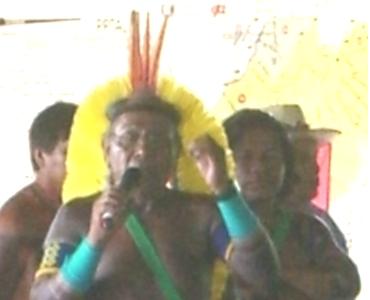|
|
World Social Forum in Belem, Brazil
an article by KDJ
This year's World Social Forum took place in Belem, Brazil, in
the Amazon region, the greatest forest on the earth. It brings together
the many social movements opposed to the politics of domination
represented each year by the multinational corporations and financiers
at the Forum of Davos in Switzerland.
This year, for the first time, the indigenous peoples spoke as
an important voice of the forum. They came from all the Amazon, which
includes part of most countries in South America. They came by bus over
distances that often required at least a week of travel, coming
directly from their villages in the forests and along the rivers of the
Amazon. They came in their warpaint; one indigenous woman explained to
me that they consider themselves engaged in a fight to save their
forest from exploitation and destruction by the big companies of
mining, wood, etc. For them the forest is life itself, and is essential
for the transmission of their traditions and cultural identity. If the
forest cannot be saved, they cannot survive as a people.

Belem participants
photo by KDJ - click on photo for enlargement
The struggle of the indigenous peoples served as a symbolic
representation for all the social movements participating in the forum,
working for the environment and for human rights. The first day of the
Forum was consecrated to their presentations, and at the end of the
Forum, their demands were reflected in most of the workshop conclusions
. Even the defense of the Palestinians, ravaged by the recent Israeli
invasion, was often seen as the struggle of an indigenous people to
save their land against outside domination.
Another high point was the response of five South American
presidents who were invited to the Forum. Their speeches supported the
themes of respect for indigenous peoples, the respect for Mother Earth,
independence from domination by the United States, and the need for
solidarity of all Latin American countries in the face of the world
economic and political crisis.
There were 135,000 inscribed participants, largely young, most
from the region in and around Belem, many living in the camping village
of the Forum. The spirit in the Forum was marked by their spirit, their
music, their dance, their bohemian dress and lifestyle. The atmosphere
was one of solidarity, sharing and exchange of contacts and ideas.
As always, there was a broad representation of civil society
associations, NGOs, trade unions, social scientists and researchers
coming from around the world. At the same time there was a conspicuous
absence of the United Nations, of UNESCO, and a decrease in
participation by North Americans.
The challenge posed by the indigenous participants for a new
consciousness of respect for the planet and its inhabitants raises
indirectly a question about the future of the Forum. Should it remain
an informal space of dialogue and energy, or should it develop a more
formal structure and strategy? Can the work of the Forum stimulate the
birth of a new consciousness? To do so, must it not go beyond its role
as a counterpoint to Davos?
|
|







 |
DISCUSSION
Question(s) related to this article:
The understanding of indigenous peoples
Can it help us cultuvate a culture of peace?
As a reader, you are invited to join in the discussion of this
article based on any of the above question(s): just click on the
question, read the previous comments and add a new reply. You may also
enter a new discussion topic on this article - see bottom of this page.
Thematic forum(s) in which this article is being discussed:
OTHER THEMES
LATEST READER COMMENT:
[see below for English version.]
Je
pense en effet que dans nos sociétés dites ''développées'' nous avons
égaré une partie de notre mémoire originelle, celle où nous avions
gravé et dessiné nos peintures rupestres, parmi les innombrables
découvertes de notre apprentissage d'Homme.
Ceci, au profit de valeurs matérielles qui nous ont éloignés de plus en plus de la matrice naturelle de notre environnement.
Nous ne partageons plus les choses simples; notre symbolique préfère le profit.
En
lisant le texte sur la Cérémonie Iroquoise de l'Arbre Blanc de la Paix
et son commentaire, je me suis souvenue d'un texte magnifique qui bien
que vieux de plus de 150 ans ( daté de 1854), a gardé toute son
actualité. Il s'agit de la réponse du Chef Seattle au Gouverneur
Isaac Stevens qui offrait d'acheter une large zone du territoire
indien, et promettait une réserve pour le peuple indien.
Cette page a été décrite comme une des plus profondes déclarations faites sur l'environnement.
"Comment
peut-on vendre ou acheter le ciel, la chaleur de la terre ? Cela nous
semble étrange. Si la fraîcheur de l'air et le murmure de l'eau ne nous
appartiennent pas, comment peut-on les vendre ?
Pour mon peuple, il n'y a pas un coin de cette terre qui ne soit
sacré. Une aiguille de pin qui scintille, un rivage sablonneux,
une brume légère, tout est saint aux yeux et dans la mémoire de ceux de
mon peuple. La sève qui monte dans l'arbre porte en elle la mémoire des
Peaux-Rouges. Les morts des Blancs oublient leur pays natal quand ils
s'en vont dans les étoiles.. . ...more.

|
|





